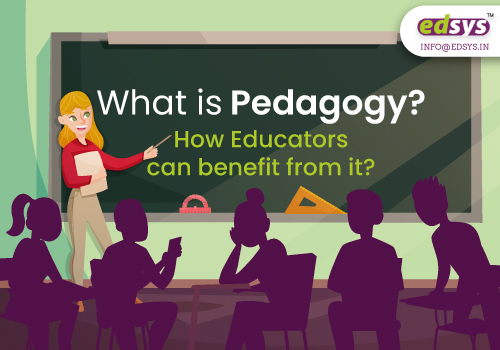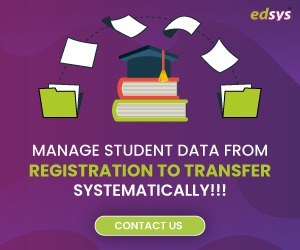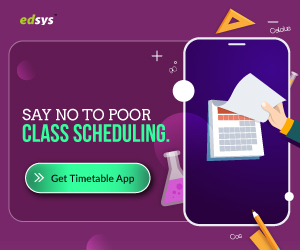Categories(658 Blogs)
Select Category
Watch Right Now
Teacher App - Class
Schedule & Attendance Management App
Parent App from Edsys

Best School Bus Tracking System

Cashless School - For Smart Schools of Tomorrow


What is Pedagogy? How Educators can benefit from it?

In the simplest way, pedagogy can be defined as the art and science of teaching.
According to etymology, pedagogy originated from Greek and means, “the art of teaching children”.
To be more specific, ‘paidos’ means ‘child’ and ‘agogos’ stands for a ‘leader’ in Greek, and ‘pedagogue’ stands for a teacher.
According to Greeks, ‘paidagogos’ were slaves, given the task of taking boys to and back from school, teaching, and tutoring them.
Get FREE Teacher Apps (Check it Now)
What is Pedagogy?
Most often, pedagogy is confused with the curriculum.
The latter means what is being taught, while the former refers to the ways involved in teaching, the theory and practice involved in educating.
Pedagogy is the relationship between an educator and learners, with respect to culture and techniques that are being used for learning. It is formally focused on educator’s belief on how learning should take place.
What is needed most in pedagogy is a healthy classroom interaction and mutual respect between educators and learners.
It focuses on building prior learning and developing skills and attitudes and, for educators to present curriculum in a most appealing way to students, by merging it in a way to suit to their needs and culture.
In pedagogy, materials used don’t matter but the process and strategy adopted by the teacher are counted.
It takes into consideration the context in which learning should take place and the type of students to whom it should be conveyed.
History of Pedagogy
The roots of ‘teacher’ can be traced back to Ancient Greece, with Socrates in 5th century BC as the cornerstone to what we consider now as modern education.
It is believed that the first schools appeared in England, during 597 AD. The first school was King’s School in Canterbury, Kent. These early schools have links to churches where students are granted spiritual education
The Academic Curriculum of those days can be divided into two.
- Trivium
- Quadrivium
Trivium comprises rhetoric, grammar, and logic, while the other comprises of geometry, astronomy, arithmetic, and music.
Lessons took the form of lectures, with a teacher leading the students whilst he/she reads and explains the text to students.
As of now, group discussions were conducted. Pupil were given topics to discuss amongst themselves and the final doubts were clarified from their masters.
Why is Pedagogy important?
Having a well-structured pedagogy can enhance both the teaching and learning process and it can be reflected in student’s performance too.
A clear-cut teaching method will help students to have a deeper grasp of fundamental material. As a teacher, you should be mindful of the way how effective you can convey lessons to students and how it helps you better understand and can help students to achieve deeper and valuable learning.
Thus it builds cooperative learning environments. This structured approach paves way for students to think outside the box. As defined in Bloom’s taxonomy, their thinking level can vary from basic memorization and comprehension to complex learning processes like analysis, evaluation and creation.
So, it helps to leverage students learning process in an appealing manner, in a way they wish to learn. It can bring out more positive outcomes in students’ learning as they enjoy learning through this strategy.
Pedagogical Approaches
Teachers will use different pedagogical strategies with respect to the age of the pupil and the content.
They will do research from varying academic disciplines and will choose a strategy appealing to the students in front of them.
For example, a playschool teacher adopting EYFS system may prefer cognitive development research.
The justifications behind these decisions will later become pedagogical principals and every teacher will develop his/her own pedagogical strategies and principals over time.
Let’s see What are the Pedagogical Approaches?
Pedagogical approaches can be broken down into four:
- Behaviorism
- Constructivism
- Social constructivism
- Liberationist
(1) Behaviorism
The behaviorist approach is teacher-centered; it uses the theory of behaviorism. This approach promotes the use of direct instruction and lecture-based classes.
Behaviorist theory was put forward from the pedagogical research by Throndike (1911), Pavlov (1927), and Skinner (1957). According to this approach, the teacher plays a key role, in delivering lessons.
Knowledge is delivered in a curriculum where each subject is taught independently to the learners.
In a lesson taught using the behaviorist approach, adopts different methods like learning, choral repetition, modeling, demonstration, etc.
All these activities are visible and are led under the direct supervision of a teacher.
However, as the lessons, progress shift may come when it becomes student-centric, and he/she demonstrates a lesson.
This approach is often described as a traditional teaching style.
(2) Constructivism
Constructivist pedagogy is a child-centered approach, where learning takes place through experiences and reflections.
In this, students are to incorporate project work; inquiry based learning, and sometimes adopt a Montessori or Steiner Method. This approach is also termed as ‘invisible pedagogy’.
The constructivist approach came into existence from the research of Piaget(1896- 1890). According to him, a teacher should incorporate activities to facilitate learning. Younger children work physically whereas, older ones tackle symbolic and abstract ideas.
Lessons might include hidden outcomes, individualization, a slower pace, and less teacher talk. Teachers also engage students with nature and to be outdoors.
This approach is also described as a progressive teaching style.
(3) Social Constructivism
Social constructivist approach was developed by cognitive psychologist, Lev Vygotsky.
He argued at the ideas of Piaget, that learning could happen only in social context and he believed that learning was a collaborative process between a learner and a teacher.
In a classroom setting, a teacher may use group work, but by building smaller groups, and limit the choice of topics. The teachers might include strategies such as questioning, group discussions, individual presentations, etc.
(3) Liberationism
Brazilian educator, Paulo Freire put forward the concept of Liberationist pedagogy. He was the director of the Dept. of Education; he developed an approach where he was able to make illiterate adults to read in just 45 days. He wrote the famous book ‘Pedagogy of the oppressed’.
In this book, he demonstrates learning as a liberationist approach and that democracy prevailed in the classroom.
The mode of learning is child centered and the teacher also becomes a learner and they discover things together.
In the classroom, teacher provides opportunities for students to showcase their learning; they can choose the form of a speech, dance or performance.
Get FREE Teacher Apps (Check it Now)
What are the Different Aspects of Pedagogy?
There exist four different aspects of pedagogy.
It includes-
- Social Pedagogy
- Critical Pedagogy
- Culturally responsive pedagogy
- Socratic pedagogy
1) What is Social Pedagogy?
According to social pedagogy, education is crucial to a child’s social development and it continues to support one’s growth throughout his/her life.
Thus education and social aspects must go hand in hand, since students are social beings; they need education for effective communication.
2) What is Critical Pedagogy?
The main aspect to which critical pedagogy looks upon is to break down and deconstruct typical worldviews regarding learning and topics. It often includes radical thinking and critical theories.
The objective is to challenge students to question their thoughts, ideas, beliefs, and practices to obtain deeper insight on things.
Thus resulting in them finding and figure out things in their own ways.
3) What is Culturally Responsive Pedagogy?
In a culturally diverse society, teachers should adopt culturally responsive pedagogy strategies to meet the requirements of all students.
The dimensions such as personal, institutional and instructional norms are put together to recognize the cultural differences among students.
Different methods and approaches to learning are put forward by educators. During certain situations, institutions or teachers have to reform their policies and procedures to encourage more involvement from students.
Conclusion
As pedagogies are constantly evolving, teachers can develop their own with respect to 21st-century learning.
New advancements and innovations in the education field can be collaborated for effective learning to take place.
Pedagogy should focus on the students in front of them; they should be able to relate the concepts back to the real world even to their own lives.
Every pedagogy is different from other, strategies, and approaches used are also different.
A good pedagogy should begin well with the philosophy of your teaching methods by stating your outlines and goals as a teacher, steps involved to relate the work you do in the classroom to professional developments once they move into their career.
Then, try to relate your classroom experience around this philosophy, work with students to choose methods that invoke positive responses in them, and finally examine how you will assess and evaluate their performances.
Also Read: 18 Fun Classroom Activities For Students
It also include how you will integrate technology to enhance learning.
These are the ingredients for a successful and result oriented pedagogy. The more aware you are of your ways of teaching, the more you will get to know what works best for students.
Recent Blogs
Our Educational Services
Popular Blogs
Subscribe

SUBSCRIBE TO OUR NEWSLETTER
Sign Up and Recieve the Latest News
Don’t Worry, We Don’t SpamExplore Our Extensive Researched Educational App Directory
Visit Now

















